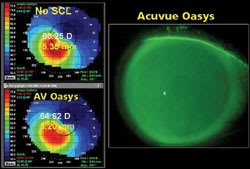contact
lens case reports
Interpreting
Piggyback Fluorescein Patterns
BY PATRICK J. CAROLINE, FAAO,
& MARK P. ANDRé, FAAO
|
|
|
Figure 1. Patient JB with advanced keratoconus OD and early keratoconus OS. |
Patient JB has advanced keratoconus in the right eye and mild keratoconus in the left. Simulated K readings were OD 55.12 @ 55/70.00 @ 145 with an apical radius of curvature of 63.25D (3.90mm), OS 45.75 @ 158/47.87 @ 68 (Figure 1). After numerous failures with GP contact lenses, JB came to us for a custom soft contact lens to serve as the base for an eventual piggyback fitting.
Fortunately for him, JB first saw one of our forth year optometry students who naively fit him with a standard Acuvue Oasys (Vistakon) lens with an 8.4mm base curve. To our surprise, it fit perfectly (Figure 2). We have subsequently used the Oasys lens for patients who have even more advanced keratoconus with great success. It appears that the low modulus of the senofilcon A material (water content 38 percent, Dk 103) allows it to accommodate a wide range of corneal shapes.
Fitting the GP Lens
We performed corneal mapping over the surface of the soft lens to establish the new corneal shape, then diagnostically fit the patient with the new aspheric I-Kone lens design (Valley Contax). Figure 3 shows how we use fluorescein to better visualize the fitting relationship of the GP to the underlying soft lens. It's clear to see when the appropriate lens-to-lens fit has been established.
Today, JB wears his piggyback lenses 14 hours a day with excellent comfort and a VA of 20/25. Most importantly, he enjoys the return of his binocular vision.
Take-away Pearls
|
|
|
Figure 2. Corneal mapping without (top left) and with (lower left) the Oasys soft lens; (right) fluorescein stained Oasys lens OD. |

|
| Figure 3. Fluorescein patterns of three different I-Kone contact lenses over the surface of the soft contact lens. |
This case demonstrates two important piggyback fitting pearls. First, the Acuvue Oasys lenses appear to have a low enough modulus to accommodate a wide range of corneal shapes, making it ideal as a piggyback soft lens. Second, you can successfully use standard fluorescein to evaluate the fitting relationship of a GP to the surface of a planned replacement silicone hydrogel lens in a piggyback system.
Patrick Caroline is an associate professor of optometry at Pacific University and is an assistant professor of ophthalmology at the Oregon Health Sciences University. He is also a consultant to Paragon Vision Sciences and SynergEyes, Inc. Mark André is an associate professor of optometry at Pacific University. He is also a consultant for Alcon Labs, CooperVision and SynergEyes, Inc.





